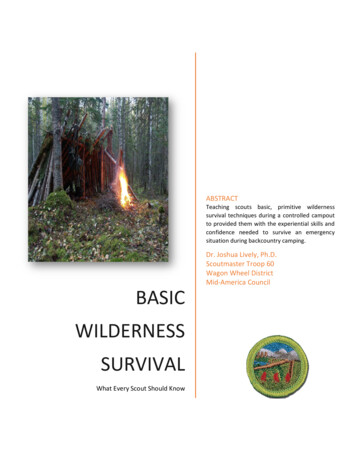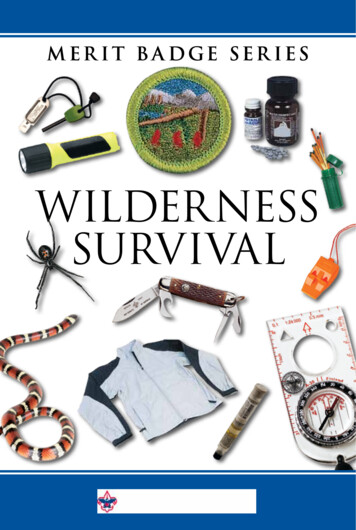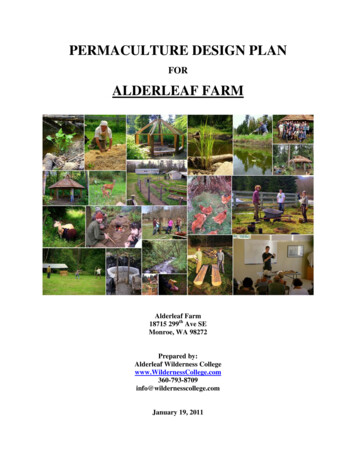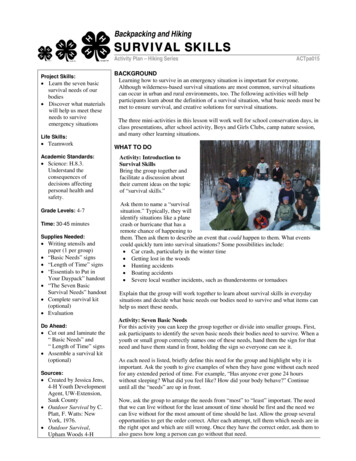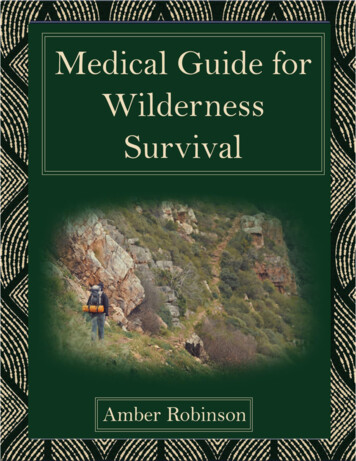
Transcription
Medical Guide for Wilderness Survival1
Medical Guide for Wilderness SurvivalTABLE OF CONTENTSThe Top Three Basic Needs to keep you Healthy . 5Food: Common Wilderness Edibles For Maximum Nutrition . 5Cattails . 5Acorns . 6Conifer Trees . 7Wild Carrot/Queen Anne’s Lace . 8Jerusalem Artichoke . 8Lambs Quarters . 9Watercress . 9Dandelion. 10Wild Mushrooms. 10Wild Game and other Sources of Protein . 11Water: Sources And Tools For Safe, Clean Drinking Water . 12Tap Trees . 12Dig a Pit. 13Collect Rainwater . 13Collect Morning Dew . 13Plans with High Water Content . 13Dig a Well on the Beach . 13Melt Snow or Ice . 13Plant Transpiration. 14Shelter: Building A Place To Keep Warm And Dry . 15Basic String and Tarp . 15Snow Cave . 15Teepee. 152
Medical Guide for Wilderness SurvivalPredator Protection . 16Treating Wounds: From Disinfecting to Healing . 17Yarrow for Bleeding and Wound Cleansing . 17Self-Heal/Woundwort for Cleansing and Treating a Wound . 18Plantain for Field Dressing . 18Chamomile and Related Plants for Reducing Wound Inflammation . 19Calendula for Healing Wounds . 19Treating Sprains, Contusions, and Inflammation . 21Arnica . 21Helichrysum . 22Comfrey . 22White Willow. 23Treating Diarrhea and other Stomach Issues . 24Agrimony . 24Mints . 25Slippery Elm . 25Black or Red Raspberry Leaf . 26Goldenseal . 26Treating and preventing rashes from poisonous plants . 27Jewelweed/Spotted Touch-me-Not . 27Witch Hazel . 28Other Effective Strategies . 28Treating and preventing insect bites and stings . 29Yarrow . 29Pennyroyal . 29Fleabane . 30Bee Balm . 30Plantain. 31Lavender . 313
Medical Guide for Wilderness SurvivalCatnip . 31Preventing and treating sunburn . 32Mud/clay to Avoid Burning . 32Wear or Weave a Hat . 32Stay in the Shade during Peak Hours . 33Aloe Vera . 33Cool Compress with Healing Plants. 33Snake Bite First Aid . 34Try not to Move . 34Remove Constricting Objects . 35Pressure Bandage and Tracing the Area . 35Avoid. 35Wilderness Injury: ABCDE Method and Patient Examination . 36ABCDE Method . 36Patient Examination . 36Handy Supplies. 374
Medical Guide for Wilderness SurvivalTHE TOP THREE BASICNEEDS TO KEEP YOUHEALTHYAny survival expert will tell you that the top three most important things you can have toensure survival include food, water, and shelter. This first chapter will elaborate on thesethree factors so you can live your best life when you are off-grid.Food: Common Wilderness Edibles For MaximumNutritionFood gives us the vitamins, minerals, and nutrition we need to stay healthy. And mostimportantly, if you are in a survival situation, it can provide you with energy. This energywill be vital if you want to retain the ability to hunt, forage, build a shelter, and treatpotential injuries. Proper nutrition will also give you the mental clarity you need to makequick decisions in a place where the line between life and death can be quite thin at times.CattailsCattails are a very common plant. You will usually find them growing in marshy areas.Many parts of this plant are edible, including the roots, young shoots, and pollen heads.The roots can be used to make a nutritional flour source. They can be hard to pull up- youmay find that they stick deeply down into the mud and muck.Your best bet for easy removal is to firstloosen up the rhizomes by feeling downthe base all the way down until you touch arhizome. Grab it and push/pull it back andforth until it feels loose. Now you areready to pull it completely out of the mudwithout too much of a struggle (remember,energy conservation is important). Onceyou have done this, collect as many cattailrhizomes as you can. It never hurts to5
Medical Guide for Wilderness Survivalhave a good stockpile. Fully separate the rhizomes from the stalk and then wash them well.Remove the corms (small nubs at the base of the rhizome). Peel the rhizomes with a sharpknife or potato peeler. You are now ready to get the starch from the rhizomes.There are several ways to do this, but one of the easiest ways is to break apart the rhizomeswhile they are sitting in a bowl of water. Work it in your hands while it is underwater andyou will notice white starch start to float inside the bowl. Let the bowl set for a few hoursand then carefully skim off the water to reveal all the starch settled at the bottom. Let thisthoroughly dry.When the starch is dry, you can grind it in a mortar and pestle. If you don’t have one, youmay be able to do what Native Americans did and find a rock with a small indent to sit thestarch and another rock to smash and grind the starch. Store this in a cool dry place untilyou are ready to use it.You can identify cattails by looking for long stalks with what looks like a “corn dog” on top.When they are in bloom, they are a medium to dark brown color and fuzzy. When you splitopen the top, out will flow a fuzzy substance. Cattails can get quite tall, with some reachingten feet in height.AcornsYou might consider acorns “deer and turkey food,” but these common seeds from the oaktree are another useful flour source. They do need to be prepared a certain way to avoidissues from the tannic acid, but it is entirely possible to process these for humanconsumption.When looking to collect acorns, find an oak tree and check out the ground below. Whenyou find an acorn, look it over good. The worms get to some acorns first, ruining them. Youwill know if a worm has entered the acornwhen you see a small hole. Collect as manygood acorns as you can. When you have asuitable amount, shell each acorn, removingthe somewhat tough outer layer and the cap(if it is still on there).Next, you will need to grind them as muchas possible. Some people do this in a foodprocessor, while others do it by hand. If youdo happen to use a food processor, addwatertomakea“smoothie-like”6
Medical Guide for Wilderness Survivalconsistency. Adding water will not hurt the process, as you will be adding plenty of waterfor this process anyway. Once you have them ground, soak them in two to three changes ofwater.There are several ways to wash them to remove tannic acid, but if you are in the wildernessand have access to running water, you can place the meal (in an appropriate container thatallows water to pass through while keeping the mash) in a stream for a day to wash. Youmay also boil the mash for six to seven hours, changing the water every 45 minutes.Finally, you will need to dry out your washed mash by spreading it on a screen or dry, flatsurface in a place with good air flow until it is fully dried. When it is fully dried, you canfurther grind it if you choose.Acorns can be identified by their appearance. They are seeds with a smooth, hard outershell and often have a “cap” on top. They range in color, but are usually a shade of brown.They will have a tiny, pointed tip or nipple at the opposite end of the cap. Sometimes thecap has fallen off, so be aware that not all acorns will have one. Acorns are often abundantin the fall.Conifer TreesThe inner bark of nearly all conifer trees can be a very useful and nutritional source ofsurvival food. The inner bark of conifer trees is full of sugars, starches, and a fair amount ofcalories. Collect the inner bark and process it by scraping out the fibers and cooking them awhile to make them more palatable and digestible.A conifer tree is a tree that produces cones. The only type of conifer tree that is not safefor human consumption is the yew tree, which can be identified by its red berries.The needles of some conifer trees arealso a great source of vitamins A and C, aswell as antioxidants. It is said that theneedle tea was once drank to treatscurvy. Look for pine trees and collect asmall amount of the needles. Place themin a cup and pour hot water over them.Let this infuse for a few minutes beforedrinking. Trees like the Douglass fir,White Pine, and Eastern White Cedar areall perfectly safe to use.7
Medical Guide for Wilderness SurvivalWild Carrot/Queen Anne’s LaceThis common, widespread, and often invasive plant is in fact a type of carrot and may havebeen used extensively by indigenous people, both as a source of food and medicine. Theroots of the plant do not look like your typical, cultivated carrot.Most of the time, they are white to cream incolor. Dig up the roots (save the flowerheads because they are edible too) and cleanthem well before cooking. The roots arestarchy and make a good food for energy andnutrition. The flower heads can be fried (youcan make fritters) and have a faint carrot-likeflavor as well. Use a few of the seeds toflavor soups and broths as well.Wild carrots can be identified by their white, often circular, flower head that appears in thesummer. Sometimes, you may notice one or a few dark purple to red flowers in the verycenter. The leaves look very much like carrot leaves. The root will smell like a carrot.Jerusalem ArtichokeDid you know that this common roadsideplant has a very thick, tuberous root? It isedible, and can be prepared much like youwould a potato. This tall plant with yellowflowers is in fact a type of sunflower. Thetuber is a source of protein, as well as acarbohydrate called inulin.The Jerusalem artichoke is a common plantthroughout North America.It can beidentified by its tall (up to nine feet in height)stalk, yellow flowers with capitate flowerheads, and large leaves with a rough, hairytexture. The leaves are larger near the bottomof the plant. Oftentimes, there may be morethan one flower growing atop the plant.8
Medical Guide for Wilderness SurvivalLambs QuartersLambsquarter is a lot like a wild form ofspinach, both in flavor and nutrition benefits.This plant is utterly packed with nutrients. Itshould be cooked in some way beforeconsumption, as this is a great way tosignificantly reduce the oxalates that may causeissues.Many plants (including cultivatedspinach) contain oxalates.Simply blanch,steam, or stir fry the leaves before consumingthem.To identify lambs quarters, look for toothedleaves that are green with a whitish-graypowdery coating that is comprised of acrystalline, wax-like substance which isperfectly safe to eat. The whole plant can growfrom three to five feet in height.WatercressIf you are somewhere where there is a fresh source of spring water, not only are you veryfortunate, but there’s a good chance you can collect all the watercress you could want.Watercress is a highly nutritious wild edible, packed with nearly every beneficial vitaminand mineral you need. It is also a source of antioxidants, protein, carbohydrates, and fiber.Look for watercress around fresh springs.It prefers the shallower areas in therunning water. It is a bright green plantthat tends to grow right in the water. Theleaves are small, round, and glossy inappearance.Sometimes, small, whiteflowers emerge in clusters above theplant. Harvest the green leaves, washthem well, and eat them raw in a salad.9
Medical Guide for Wilderness SurvivalDandelionDandelions can be found in regions allover the world.The leaves areextremely nutritious, and containenormous levels of vitamin K. They alsocontain vitamins A, C, and B. They are asource of dietary fiber, manganese, iron,and calcium. Harvest the leaves, washthem well, and eat them in a salad. Theyellow flowers are also edible and canbe fried to make fritters or even madeinto jelly. The roots have been used as amedicine (usually drank infused in hotwater) for liver and kidney health.To identify dandelions, look for the bright yellow, furry flower heads. They usually emergein spring and stick around until winter. In some climates, they are around all year. Theleaves are spade-shaped, with notches or deep grooves all the way up. The root is ataproot. Be sure to harvest dandelions in an area you know has not been sprayed with anypesticide, etc.Wild MushroomsMushroom identification can be daunting for some, but if you are confident in youridentification skills, mushrooms are an excellent source of nutrition when you are off-grid.Some easy-to-identify mushrooms that arepacked with nutrients include lion’s mane(white with small, hair-like projections. Itgrows in a large, round mass), morels(emerge in the spring.They are hollow with porous, hole-filledcaps), chicken of the woods (yellow toorange in color, growing in a fan-shape),hen of the woods (also called maitake –brown to gray in appearance.Chicken of The Woods Mushroom10
Medical Guide for Wilderness SurvivalThis mushroom is often found in a large cluster), black trumpets (easy to identify with littledangerous lookalikes. They are dark grey to black in color and trumpet-shaped. They aresmall, and grow in mossy areas), and pheasant-back mushrooms (also known as dryadsaddle mushrooms. They have a distinctive cream color with brown markings that looklike a pheasant). Oyster mushrooms are another edible mushroom that can even be foundin the winter months. Always thoroughly cook mushrooms before consuming them. It ishighly recommended that you bring a mushroom identification guide with you before yougo into the wilderness.Wild Game and other Sources of ProteinMeat will give you much needed protein for energy when you are in a survival situation.Many wild animals are edible, if you’re brave and skilled enough to catch them. Squirrels,wild turkey, deer, quail, pheasant, and wild boar are all popular sources of wild meat.However, there are other animals you can eat that you may not have considered.These include raccoons, opossums, frogs (frog legs are said to taste like chicken), alligator,rats, turtles, nutria (a type of rodent), badgers, groundhogs, and river otters. By far, theeasiest way to harvest these animals will be with a firearm, but you can also use a crossbowor compound bow. If you don’t have any of these things, your best bet will be to lean to settraps and snares in hopes of catching an animal.Set them along areas that look to be trodden by animals. You may notice faint paths in thewoods where animals travel. This is a great place to try and set a trap or snare. Learninghow to clean and properly butcher an animal is a valuable skill to have as well. Alwayscook the animals well to avoid getting sick. Make sure you are aware of the hunting laws inthe area you are staying.Don’t forget that there is an abundance of food in the water. Not only can you find fish inwater, but you can catch crawfish, frogs, mussels, clams, and snakes as well. If you don’thave any luck catching a land or water creature, you can also eat many insects. Some edibleinsects include crickets, grasshoppers, ants (stay away from fire ants though), locusts, Junebugs, grubs, scorpions, termites, snails, and centipedes. These can provide you with a quickand easy source of protein in a survival situation.11
Medical Guide for Wilderness SurvivalWater: Sources And Tools For Safe, CleanDrinking WaterWater is essential for life. The human body can go without food much longer than it can gowithout water. Make this your number one priority before looking for food. When stayingin the wilderness, locate an area as close to a water source as possible (but not too closeyou don’t want your camp to be washed away by flash flooding). If possible, a fresh sourceof running water is preferred, although most water can be boiled to kill any bacteria thatcould cause illness. In this section, you will learn how to locate and use water to ensureyour survival.Tap TreesMany trees produce sap that is mostly water, and quite nutritional. Sap collection is a greatway to get water if you are in a place with no other water source. If you can find a hollowtool to hammer into a tree, you might be able to collect some sap. Sap flows best when thetemperature gets above freezing during the daytime and below freezing at night. If youhappen to be in a climate like this, there is a good chance you can get all the sap you need todrink. You can drink it straight from the tree. However, if you happen to collect a lot ofsap, you will need to keep it cool, as it can spoil if you leave it sitting out too long. Makesure the materials you have to collect the sap (like your collections bucket) are as sterile aspossible if you intend on drinking from the tree. Sap isn’t just nutritious and hydrating, insome places it is considered medicinal. Sap tapped from birch trees is especially medicinaland some people drink it as a tonic for their health. Filter the sap before consuming it.Below is a list of trees you can tap for sap:All maple trees – sugar maples are the most popular because they have a higher sugarcontent (making the syrup pretty tasty) but other species work just as well for sapcollection.Birch – as previously mentioned, birch trees produce sap that is hydrating and possiblymedicinal.Boxelder – The sugar content of this sap is much lower than a maple, but these trees doproduce sap.Walnut – The syrup made with sap from this tree has a slight nutty flavor, so the sap willlikely have a faint nutty flavor as well.Sycamore – Sycamores produce sap, but don’t expect them to produce a lot. The syrupmade from the sap of this tree is delicious.12
Medical Guide for Wilderness SurvivalDig a PitIf you are having a hard time finding water, look for areas that appear wet and have a lot ofgreen vegetation. These are ideal for digging to reach water. Dig as much as you can, atleast three feet. You should start noticing water creeping in. Other places to dig include lowareas like at the foot of a cliff and a dry river bed. Any water collected from these pits willbe muddy and will need filtered and boiled before you drink it.Collect RainwaterDon’t let the rainwater go to waste if you need water. Try to collect as much as you can bysitting as many containers as you have around to catch it. Another efficient way to collectrainwater is to tie a tarp a few feet off the ground and place a rock in the center to make itfunnel downward. This will catch a good amount of rain. The great thing about rainwateris that you don’t have to boil it before drinking it. It is a fresh and clean source of water.Collect Morning DewThe early morning is the perfect time to go out looking for heavy dew that falls on plants.One easy way to collect this is to tie absorbent cloths around your ankles and take amorning walk through heavily dewed areas. When you are finished, wring the cloth out toget the water. Avoid walking through any potentially poisonous plants.Plans with High Water ContentSome plants contain more water than others, making them potentially helpful if you needhydration. Look for cacti (they often contain a high amount of water because they areaccustomed to storing it for survival), fruits, vegetables, and coconuts. Coconuts are anespecially handy source of hydration, as they contain a decent amount of water. For fruits,vegetables, or any other plants that appear pulpy, mash them in a container until they haveliquefied and drink the water. You are not likely to get a lot of water from these plants, butif you are in a survival situation, it can help.Dig a Well on the BeachIf you are in a tropical location with only seawater, you can try digging a well on the beachat least 100 feet away from the salt water. Dig this well up to five feet deep. Place rocks atthe bottom and line it with driftwood to keep it from collapsing. It should fill up with freshwater that has been filtered by the sand. If it tastes salty, move back from the water evenfarther and dig another pit.Melt Snow or IceIf you live in a climate with lots of snow or ice, you can melt this to drink. Avoid eatingsnow or ice while it is still frozen, as this can lower your body temperature (which can13
Medical Guide for Wilderness Survivalresult in dehydration). If the region where you are staying has only salt water but isfreezing, you can collect some of the salt water and sit it somewhere to freeze. Fresh waterfreezes first. What remains is salt water “slush.” Simply discard the slush and heat thefrozen fresh water before drinking.Plant TranspirationThe underside of the leaves on a tree receives moisture from the roots. Usually, thismoisture vaporizes into the air and we never see it. You can collect this moisture bywrapping a tree branch in a tarp or bag and making sure it is tightly gathered and tiedaround the branch. Place a small rock at the bottom to collect the water.14
Medical Guide for Wilderness SurvivalShelter: Building A Place To Keep Warm And DryHaving a shelter is in the top three most important things you can have in the wilderness ifyou want to survive and stay healthy. A shelter keeps you from being exposed todangerous elements that can lower your body temperature in cold weather or give youheat stroke in very hot weather. Build your shelter near water if at all possible. In a hotclimate, make sure you have a well-ventilated place to get out of the sun. In a cold climate,make sure you have a place that is as insulated as possible to avoid cold winds. In anyclimate, make sure you have a good roof to keep from being exposed to precipitation thatcould lower your body temperature. If you are somewhere with bugs that bite and sting,you may want to make sure your shelter is elevated a bit off the ground.Basic String and TarpOne simple shelter design is taking a string and tying it from one tree to another severalfeet away. Next, you would drape a tarp over the string. This gives you two sides ofprotection from wind and a roof to keep you from getting rained on. If
Medical Guide for Wilderness Survival 3 . You might consider acorns “deer and turkey food,” but these common seeds from the oak tree are another useful flour source. They do need to be prepared a certain way to avoid . heads, and large leaves with a rough

